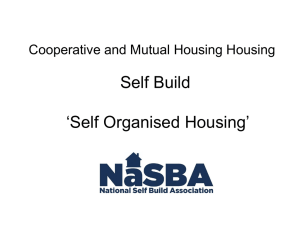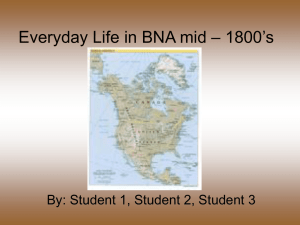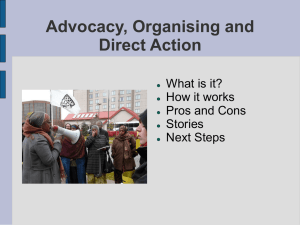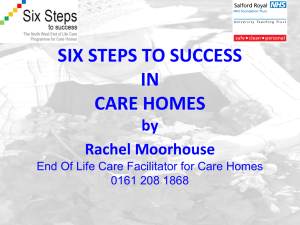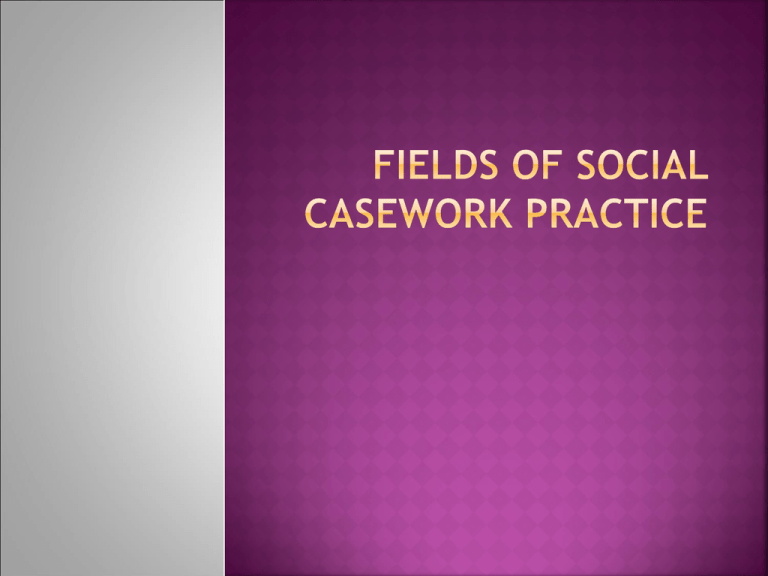
•
•
•
By stressing the fact that casework help is not
standardized. As we go along, we shall talk about
different factors that may determine caseworker’s
differential response to a similar situation.
The individual, the client, is seen as a whole – as a
thinking, feeling, and acting being - in continuous
interaction with his total social environment.
You, as the Social Caseworker, represent not only
the agency which has employed you but also your
profession – Social Work. That is, you have to
practice (use knowledge and skills & techniques)
within the professional value-system, ethics and
principles but at the same time be responsible for
achieving the goals of the employing agency.
•
•
•
•
While you generally work within the service
delivery systems devised by the organization, you
have a commitment to performing the role of a
change – agent in case these systems are
dehumanizing or degrading for the clients.
You have to be constantly aware of your personal
self and make sure that it does not interfere in your
social casework practice.
It is all the more important in Social Casework
because its clients’ problems and concerns have
heavy emotional component.
Human problems of living are complex and
multidimensional and require sensitive handling.
•
•
•
Therefore, Social Casework Practice may very often
require interagency collaboration.
You will very often be a part of a team of
professionals. In primary settings, you are likely to
be the main professional for service delivery,
whereas, in secondary settings, you may have an
ancillary status. It is important for you to
communicate your contribution as a social work
professional to other professionals in the team.
Social Casework service may be offered for
prevention, promotion, cure/ remedy,
rehabilitation, placement, reformation, palliative
care, or for modification of social environment.
Fields
of social casework practice are broad areas
or settings in which casework method is utilized to
help individuals and families. Various fields can be
determined on the basis of the following
components:
a) Person-in-context – The context here includes
the total social environment of the client -a male
adult with visual impairment, a middle-aged woman
abandoned by her husband, an orphaned child in a
Foundling Home.
•
•
•
b) The concern or the problem requiring help –
Destitution, chronic illness requiring major changes
in life-style, drug dependence, rehabilitation,
trauma caused by riots or serious accident,
bereavement, role conflict, displacement.
c) The human service organizations that provide the
location for providing help, like, schools, hospitals,
childcare institutions, short stay homes, institutions
for the elderly and juvenile homes.
The first two dimensions can be analyzed further
from two perspectives:
a) Common human needs – beside survival needs,
every individual has needs for affection, for
security, for achievement and for belonging (to a
group).
b) Special human needs – needs that arise because a
person has a disabling impairment, is suffering from
a chronic illness requiring major changes in life
style, has deficit of coping or social skills, needs
arising due to traumatic experiences like accident,
riots, natural calamities or needs of very young or
old persons.
c) Societally caused needs – those that arise due to
certain conditions in society itself, for example,
discriminatory practices, oppression, deprivation,
or displacements due to large developmental
projects.
The needs perspective helps the worker in
understanding the source and extent of the problem
as it applies in each case. It helps in knowing about
the impact of the unfulfilled need on the client and
his social environment. The worker is able to help
the clients decide upon the action plan for dealing
with their problematic situation by fulfilling the
unmet needs.
An individual experiences a number of life changes
as he/she goes through his life cycle, that is, from
birth to death. She/he is seen as moving in life
through a series of developmental stages, each
stage requiring the individual to successfully
complete some tasks before he/she moves on to the
next one. In most cases, human beings move
through this cycle without major unsettling
stresses. But if the person is not able to achieve
this transition smoothly, he/she may find life
changes stressful and is thus unable to adapt to the
new demands.
d) The human service organizations: The
mandate of these organizations is that of
‘service’, that is, to maintain and improve
the general well-being and functioning of
people. Examples of such organizations are
schools, hospitals, correctional institutions,
and social welfare and development
agencies.
Human Service Organizations are
characterized by a) goals and objectives, b)
specific client groups, c) personnel, d)
programmes and services, e) service delivery
systems, f) Material resources and networks.
The Individual
• Person and his/her interaction with social environment
are influenced significantly by a number of factors. These
factors determine as to how different clients react to a
similar situation /problem/concern differently. Their
expectations from the caseworker may also vary
accordingly. Some of these factors are:
• Age: The needs and concerns, problems and difficulties
faced by a child are invariably different from those of a
young adult or an elderly person. Again, how the
individual--- of any specific age group --- looks at the
situation under study, feels about it and wants it to be
handled may differ according to the age of the individual.
•
•
Sex: The experiences and conditions of male and
female persons in a given society are socially and
culturally determined. The status in society (rights,
privileges and power within the family and society
at large), division of tasks, role expectation, role
transitions, and role conflicts affect men and
women differently. The stereotyping of image and
roles tend to become oppressive and discriminatory
for women specially.
Caste: In Indian society, caste based discrimination
affects individuals and families across age and sex
divisions, although females suffer the most. The
low status because of belonging to lower castes
results in deprivation, oppression, and lack of
opportunity, depression, apathy and inertia.
•
•
•
Class: The income group an individual belongs to
determine the life goals and motivation for striving for
change. Outlook towards life and problems of living are
likely to affect persons belonging to: a) lower income
groups; b) middle income groups; c) affluent groups; or
d) those who are below poverty line.
Religion: In a pluralistic society like India, belonging to
minority groups’ religion has its own difficulties.
Religion holds a very important place in an Indian
person’s upbringing. Understanding of religious beliefs,
customs and moral values is essential in helping a
person.
Region: People belonging to rural, urban or tribal areas
tend to demonstrate specific response-patterns and
preferences in life. Persons hailing from a small city, a
village or a metro city, are exposed to different stimuli.
Their life experiences will, therefore, be different from
one another. Their needs and expression of concerns
may also be different.
•
•
•
Family is a special social group wherein members are
bound to each other by blood or marriage. The main
function of family is child rearing and growth and
development of each member. Families fulfill their
social responsibility by socializing children in the
culture of the society.
In fulfilling their functions, families interact with a
large number of social systems and organizations like,
kinship network, religious and economic institutions,
schools, the work place, civic authorities, welfare and
legal framework etc. Unique patterns of interaction –
within the family (among members), and with outsiders
evolve overtime.
Family is a system wherein the experience of any one
member affects the other members.
Doctors are the main professional groups in the
hospital, responsible for medical care of the patients.
The recognition of psycho-social and cultural dimensions
of illness and hospitalization has enabled employment
of trained social workers in the hospitals. Social
Casework is utilized in the OPDs (outpatient
departments), the Wards, and Special Clinics. The heavy
work load of doctors in large Govt. Hospitals generally
leads to lack of clear communication between the
medical staff and the patients and their families. In
such a scenario, the main roles expected of social
workers are those of mediator; enabler; coordinator of
services; case manager; mobilization of family,
community and hospital resources; and acting as a
member of the team of professionals. Working with the
patient and his/her family is a major task of the social
worker. Therefore, Social Casework is a primary method
in medical social work practice
•
•
•
The caseworker works as a member of the team of
professionals including psychiatrists, psychologists and
occupational therapists. Psychiatrists are the main
professional group in charge of care and treatment of
the mentally ill or emotionally disturbed persons.
The patients may be attending OPDs, day care, or may
be hospitalized. The main tasks of the caseworker are
to maintain constant contact with the family of the
patient; mediate between the doctors and the
patient/family; provide counselling to the patient;
assist in discharge and after care of the patient.
The worker provides the necessary support to the family
and helps the other family members understand the
needs of the mentally ill person.
The patients who are suffering from chronic illness,
like diabetes, asthma, and heart disease, need help in
understanding their illness and the demands of the
treatment, and adjusting their life-styles to the
limitations imposed by the condition. The families of
the patients also need support and guidance in dealing
with the patient’s condition that may have long-term
implications for the entire family. In some cases,
especially among those belonging to lower incomegroups, the financial burden may need to be eased out
by identifying and mobilizing resources in the kinship
network or community at large. While working with the
terminally ill patients, the first dilemma the worker
faces is to inform the patient and his family about the
illness. The patients suffering from a terminal illness,
like cancer and AIDS, have additional stress factor – the
thought of impending death and anxiety about the
family after their death.
The tasks of the caseworker include:
• a) Ensuring palliative care to reduce pain and
discomfort, b) talking about death,
• c) Involving the patient in planning for the family
after his/her death, d) providing opportunity to
family members to talk about death and dying,
e) providing support--- emotional and material -- to the patient/family. In the case of AIDS, the
caseworker will need to tackle the issue of
stigma attached with contracting AIDS and the
possibility of infection getting passed on the
other family members.
Schools are institutions for formal education, with a
fixed routine, set syllabus, and a well-established pattern
of teaching and learning. Teachers are the main
professional group and they spend the maximum time
with students. Schools vary in size--- from small single
teacher schools in the villages and tribal areas to large
bureaucratic organizations with thousands of students.
Schools may offer primary, middle, secondary or senior
secondary education. Again, some may be Government
schools/aided by the Govt. or fully private independent
schools. Despite progressive and child-centered
educational philosophy, schools are characterized by
emphasis on syllabus (information content), formal
examination system for evaluating achievements and
formal teacher-child relationships.
a)
Children’s Homes: Children who are destitute, orphans, or have run
away from home and can not be sent back home; those who are violence,
risk to health (e.g., healthy children of leprosy patients) or moral danger
are generally placed in children’s homes. Most of these Homes operate
under the provisions of Juvenile Justice Act and, therefore, provide
custodial care. Children are committed for specific periods. There is
sometimes a feeling among inmates that they are under detention.
Only in a small number of cases adoption and foster care services are or
can be offered. Homes, run by the Govt. or voluntary organizations, are
expected to provide custody and care to the children. Social Worker is an
important professional here. Living arrangements may be dormitory or
cottage types.
Social Caseworker is expected to help each inmate adjust to the life
within the Home and achieve psychosocial development. As the children
have often gone through traumatic experiences before they are placed in
Homes, it is very important for them to come to terms with their life,
talk about it and get over the pain and the sense of betrayal.
The worker is expected to provide pastoral care, liaison with schools
where the children go for education, help children develop positive
relationships within the institution, and prepare for life after the stay in
the Home is over.
•
•
•
b) Correctional Institutions: These include homes/special
schools for the delinquent, prisons, remand/observation
homes, beggar homes etc. The main task of the Social
Caseworker is to help those in conflict with law by enabling
them to understand themselves and their relationship with
others. They need to understand what is expected of them as
members of society.
The aim is to rehabilitate these persons – to help them in such
a manner that they can engage in socially constructive
activities once they go back to their homes. The worker helps
the clients change /modify their values (so that they are in
line with the social values); change their behavior and
response patterns. The residents of these institutions often
have a feeling of hostility towards society or they suffer from
a sense of inferiority and inadequacy.
Social Casework aims at correcting these attitudes and
feelings by modifying the clients’ immediate environment,
working with their families and maintaining a supportive
professional relationship with them. The Caseworker works as
a member of a team of professionals like, probation and
parole officers, psychologists, psychiatrists, and vocational
counsellors and educators.
c) Homes for the Aged: The number of old age homes
has been increasing in cities. The stresses and
constraints of urban living have often led to adult
children opting to send their aging parents or relatives
to residential institutions. The residents in these homes
need nursing care, understanding and emotional
support. The caseworkers in these institutions help the
residents cope with loss of the loved ones, illness, lack
of energy, loneliness, and loss of economic
independence and the thought of approaching death.
The caseworker enables the client maintain his/her
self-esteem. He/she also helps the family deal with
suppressed or open feelings of guilt so as to encourage
them to maintain cordial relation with the client. The
worker needs to identify and mobilize community
resources like motivating and orienting volunteers to
d) Residential institutions for women: Short stay homes,
rescue homes, nari niketans, widow homes etc. are some
of the settings where casework practice takes place. Most
of the inmates are those women who are destitute,
abandoned or battered by their husbands, widows with no
relative to give them support, victims of crimes including
prostitution or kidnapping. These residents need to build
their skills – vocational and social – to become
independent persons capable of taking care of their lives.
The caseworkers try to bring about conciliation between
the client and her family, if any. Where marriage is
indicated, pre-marital counseling is provided.
There are residential and non-residential organizations
offering variety of services to the differently abled. The
main task of the caseworker is to fulfill the objectives of
the organizations such as a) care; b) rehabilitation vocational training, education , employment; c) offering
services according to governmental provisions and special
concessions; d) advocacy to reduce or remove social
discrimination against the differently abled; and e)
facilitating the client’s acceptance and understanding of
his/her situation and also recognition of his/her
potential.
Victims of natural calamities are victims of floods,
earthquakes, and drought. Victims of man-made disasters
include victims of communal violence (riots), serious
accidents, mega projects of development etc. Some of
the common experiences of most of the victims of
disasters are trauma; loss of loved ones; loss of livelihood
or assets; homelessness; feeling of helplessness; feeling of
anguish or hostility (desire for revenge); loss of
community feeling; despair and a sense of fatality or
sometimes high/unrealistic expectations from the worker.
Social caseworkers are employed in family counselling
centers, crime women cells, legal aid cells, family courts
and women resource centers. The aim of the professional
interventions is to enable women become empowered,
confident, and independent and also utilizes available
legal provisions and safeguards for her protection. There
are increasing numbers of cases of rape victims. The
worker has to help link the family with police, courts,
hospitals, schools, and agencies working for rehabilitation
of these victims. Special techniques are used to help the
victim come out from trauma, and restore her selfconfidence and self-esteem.


